The cardinal is one of the most beautiful wild birds in the world, but it can be hard to find one standing still.
Cardinals are known to be shy and they are not aggressive birds.
The following cardinal bird facts will help you to better understand how cardinals function outside.
1. Male cardinals get their red feathers from food
The male northern cardinal is instantly recognizable, being completely red in color, whereas the female cardinal has tan feathers with a red wash across the chest.
However, the red wash feature varies between individual females. Male and female cardinals also have different colors in their beaks as males have red beaks and females have orange beaks.

The red coloration that males develop in their plumage is a result of carotenoids in their feather structure, and they ingest those carotenoids in their diet.
Vibrant yellow northern cardinals may be seen on rare occasions, which is a genetic plumage variation called xanthochroism.
2. Cardinals are omnivores
Birds that are omnivores are birds that can eat both plants and animals. What do cardinals eat? Cardinals love to eat seeds, fruit, buds, and insects.
Cardinals can often be found eating birdseed out of bird feeders. Cardinals also hop and forage on the ground, searching through low-lying shrubs and bushes for seeds.
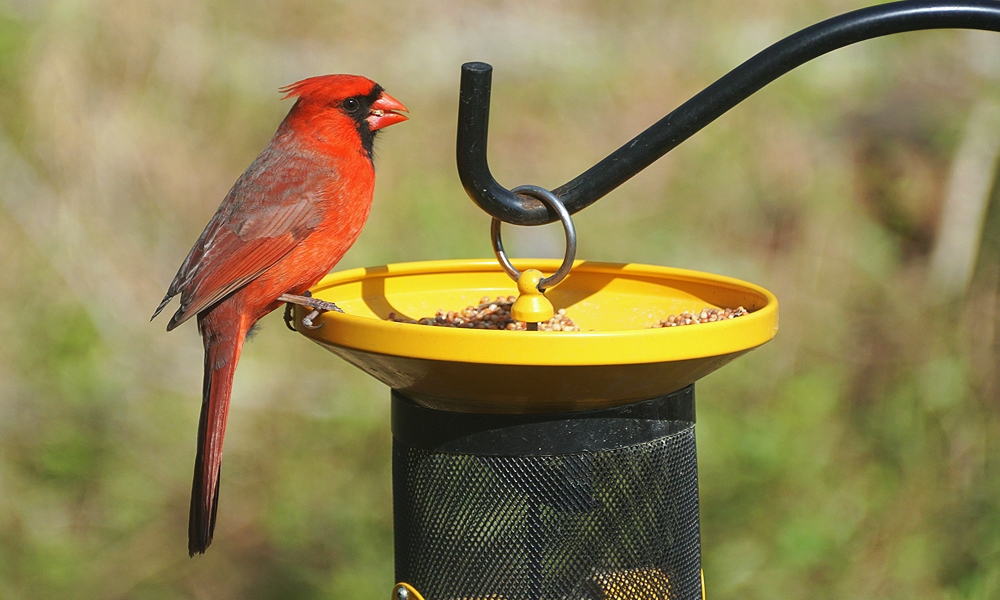
Suet, a high-calorie kidney fat that comes from sheep or cattle, provides nutrients for cardinals all year long. When insects become scarce or non-existent in the winter.
Suet is a great replacement to provide cardinals energy. Cardinals also eat grains like oats, buckwheat, millet, and bread crumbs. Read more about what to put into cardinal feeders.
3. Some cardinals suffer from bird “baldness”
It doesn’t make for a pleasant sight to see naked-headed cardinals. Parasites are mainly to blame, but some experts like Eastern Kentucky University ornithologist Gary Ritchison have their doubts.
Having personally handled thousands of cardinals, Ritchison has handled several bald cardinals (1). Among these afflicted birds, he says that “None had severe lice or mite problems.”
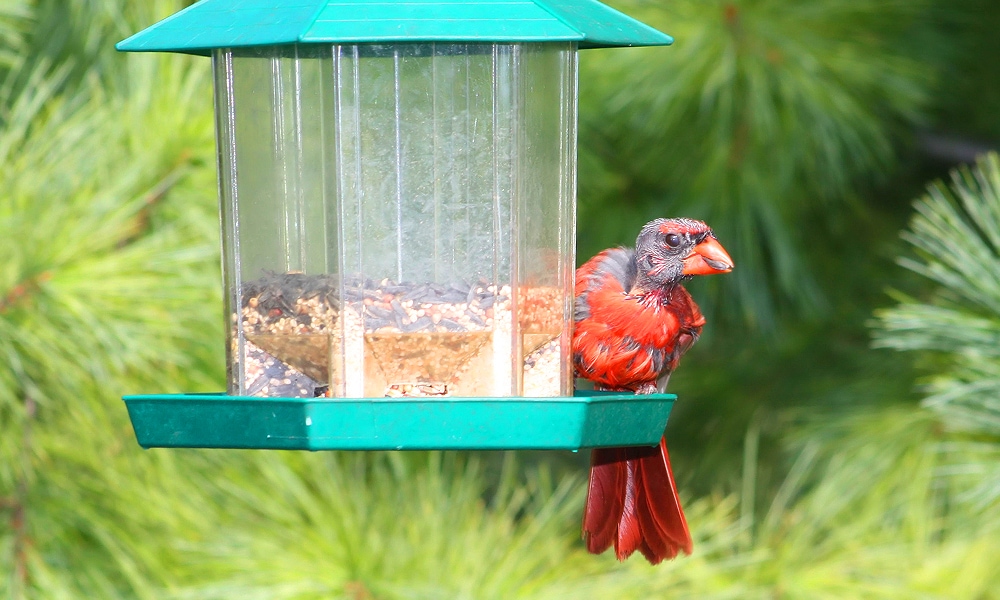
He attributes this phenomenon to an unusual molt pattern. Author of The Bird Almanac in 1999, McGill University in Quebec ornithologist David Bird, and colleague Rodger Titman, argue strongly for the unusual molting explanation. This unusual feather loss may be due to a response to a traumatic injury.
4. Cardinals are non-migratory birds
Birds that are non-migratory means that they don’t migrate for the winter season. Cardinals are non-migratory birds as they prefer to live within a mile of where they were born. They are attracted to nesting shelves and cardinal feeders, especially those with a great supply of food.
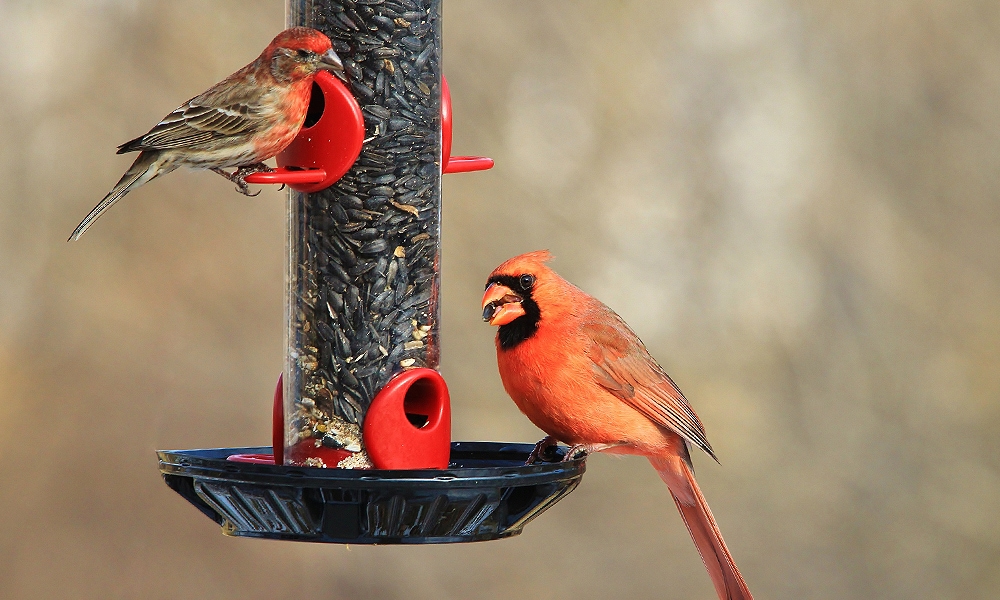
The best bird feeder for attracting cardinals would be a hopper bird feeder. These feeders allow cardinals to perch for their meal. Male cardinals can be hard to spot even though they are bright red. They mainly prefer to hang out in dense shrubs, and then tangled branches block the view of their feathers.
5. Cardinals were named after the Catholic Bishops
One of the northern cardinal facts that you may already know is that the bird was named for its color, which resembles the red robe worn by Roman Catholic Cardinals (2).
What does cardinal mean? In the Roman Catholic definition, a Cardinal is a high ecclesiastical official of the church who ranks just below the pope to assist as a member of the Sacred College of Cardinals.
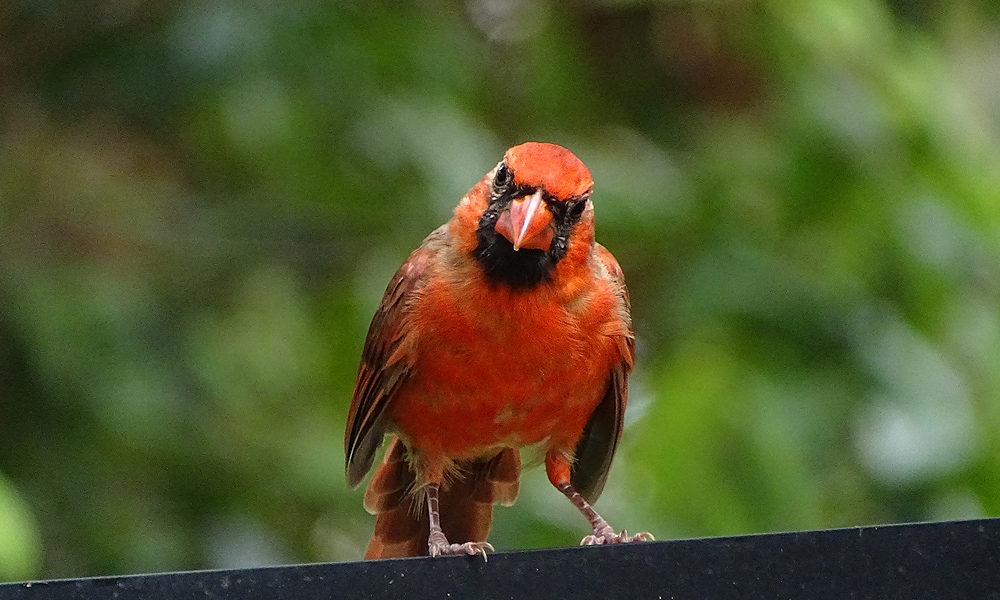
These types of Cardinals serve as principal counselors, primarily aiding the government of the Vatican. The Latin word cardinalis, from the word cardo (pivot or hinge), was first used in late antiquity to designate a bishop or priest.
6. Cardinals voluntarily cover themselves with ants
One of the most interesting facts about cardinals is that they practice what is appropriately called anting (3). In fact, over 200 species of birds, including the Baltimore Orioles and the wild turkey, also cover themselves with ants. It is possible that because the ants release formic acids, cardinals help themselves ward off lice.
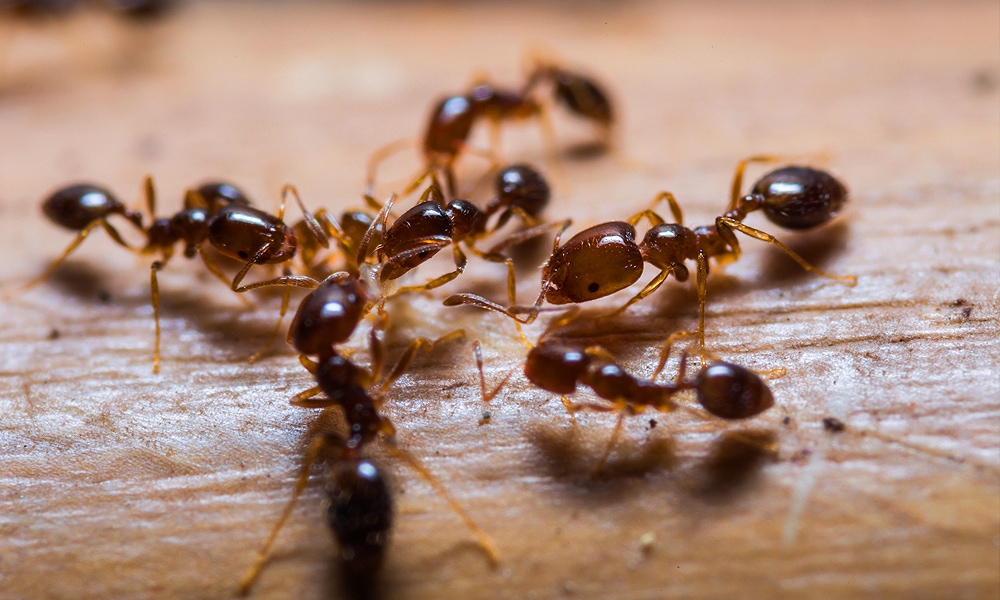
The ants come from two subfamilies, they produce defensive secretions to repel attackers, and they don’t sting. The cardinal will hold an ant in its beak, spread and lower its wings, and brings its tail forward between its legs, wiping the outer wing and tail feathers with the ant.
7. The Cardinal is a symbol of confidence and balance
The cardinal is seen as a symbol of some positive traits, and it is mainly portrayed as a reassuring sign. The cardinal bird symbolizes confidence mainly because it is known for being a confident species.
Cardinals know everything about their own distinctive gifts and talents, which explains why you won’t see them being eager to be taken in a light manner.
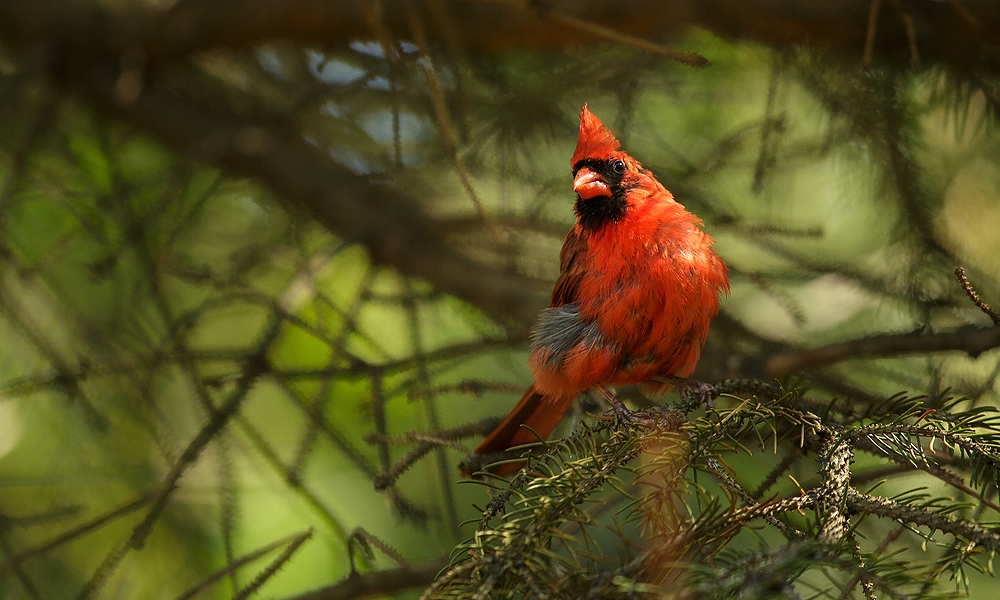
Cardinals also represent balance as they serve as a powerful representation of a family. The father cardinal is in charge of nurturing young birds. Parent cardinals live a well-balanced family life, giving both of them the chance to take care of and nurture their kids in turn.
8. Cardinals mate for life
Cardinals are monogamous birds. After a male cardinal bird has chosen a female, the two will begin building a nest using various materials like leaves, grasses, tree bark, and small twigs that they gather and weave together. You will typically see a cardinal nest lined with animal hair and soft grass.
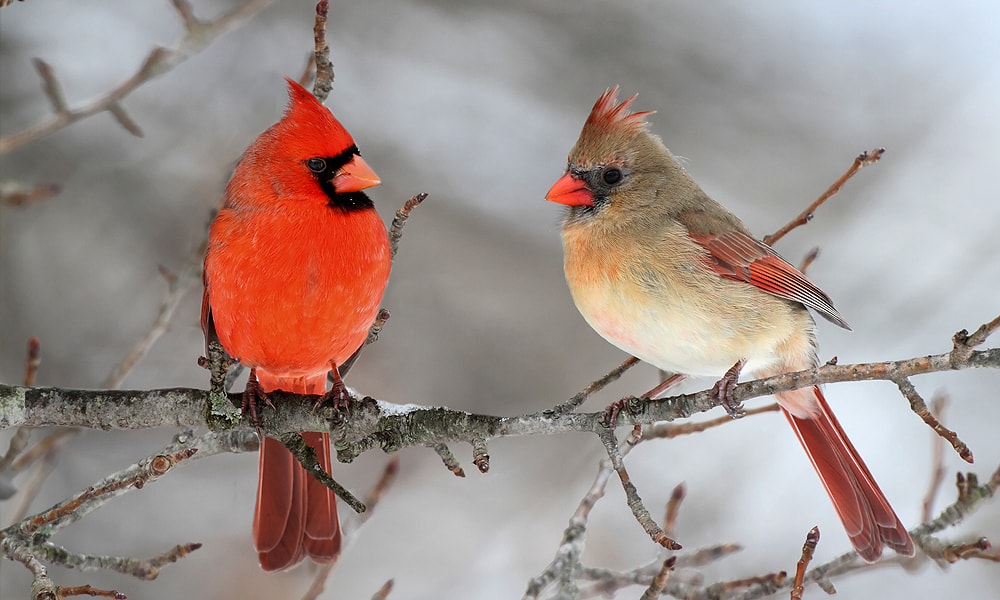
Do cardinals mate for life? Some cardinal pairs stay together all year long in their nesting territory. Female cardinals lay 3 or 4 eggs, which will be incubated for 12 to 13 days. The male occasionally helps with the incubation process. If one member of the pair dies, the survivor will quickly look for a new mate.
9. Female cardinals sing to tell the males when they need food
Cardinal sounds vary between males and females. The male typically sings to attract mates or ward off intruders. The female typically sings to signal the male to bring food to the nestlings.
The cardinal bird call for males is aggressive singing to protect their breeding and nesting, whereas females will sing more elaborate songs.
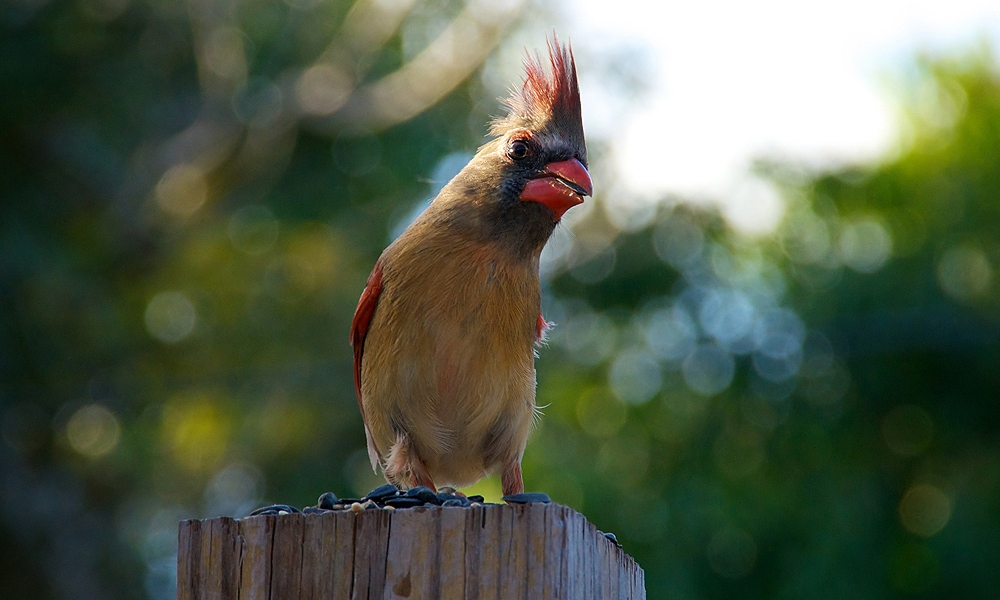
Females sing in a more tactical fashion. Cardinals have the ability to sing 24 different songs. Male cardinals may sometimes sing up to 200 songs in an hour. When you hear cardinals chirping, sometimes both the male and the female will get together and sing cheerful duets.
10. Cardinals are named as a state bird of seven states
The cardinal is the most popular state bird in the United States. These are the seven states in America that have the northern cardinal as their state bird:
Illinois (1929), Indiana (1933), Ohio (1933), Kentucky (1942), North Carolina (1943), West Virginia (March 7, 1949), Virginia (January 25, 1950).

Cardinals are also popular mascots in professional sports, most notably for the St. Louis Cardinals in baseball and the Arizona Cardinals in football.
Many college and high school teams also have cardinals as their mascots. The most notable schools that promote the cardinal would be the University of Louisville in Kentucky and Ball State University in Indiana.
11. Cardinals can live up to 15 years
How long do cardinals live? Northern cardinals can live for at least 3 years in the wild on average. However, some are able to have lifespans of 13 to 15 years. What you may find to be an amazing fact is that the longevity record for a northern cardinal in captivity is 28 ½ years (4).
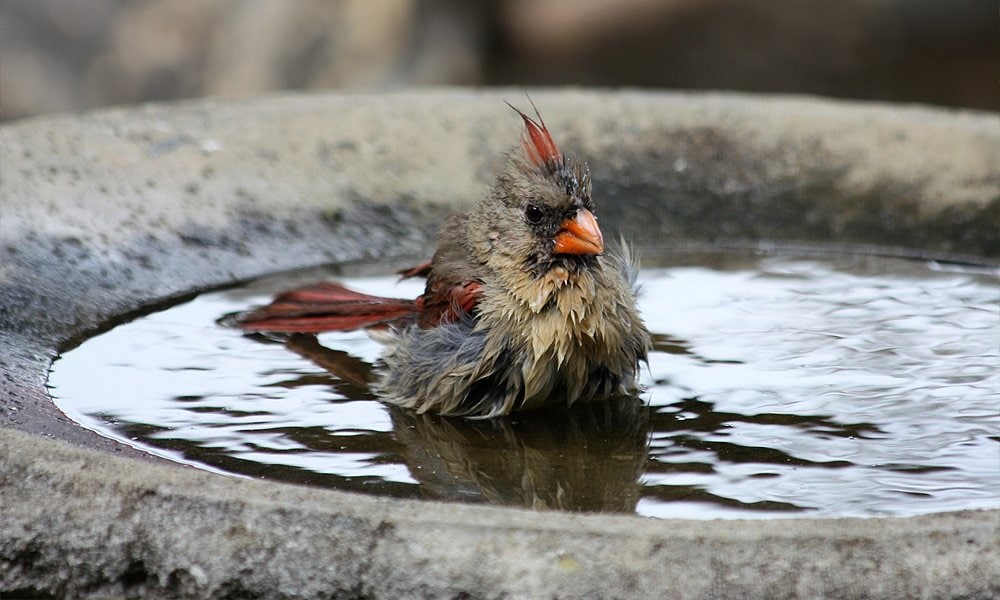
Most wild birds tend to live very long, especially if they are the type of birds that dwell in higher altitudes, which usually come to little or no harm throughout their lifetime. Combined with the fact that they shy away from humans, the preference to dwell in higher altitudes helps cardinals live longer.
12. During winter they tend to create big flocks
In the warmer months of the year, cardinal pairs aggressively defend a plot of land sized between 2 and 10 acres, which gives one the impression that they are territorial in the winter season when food becomes more scarce. Cardinal pairs will actually join forces in their quest for sustenance.
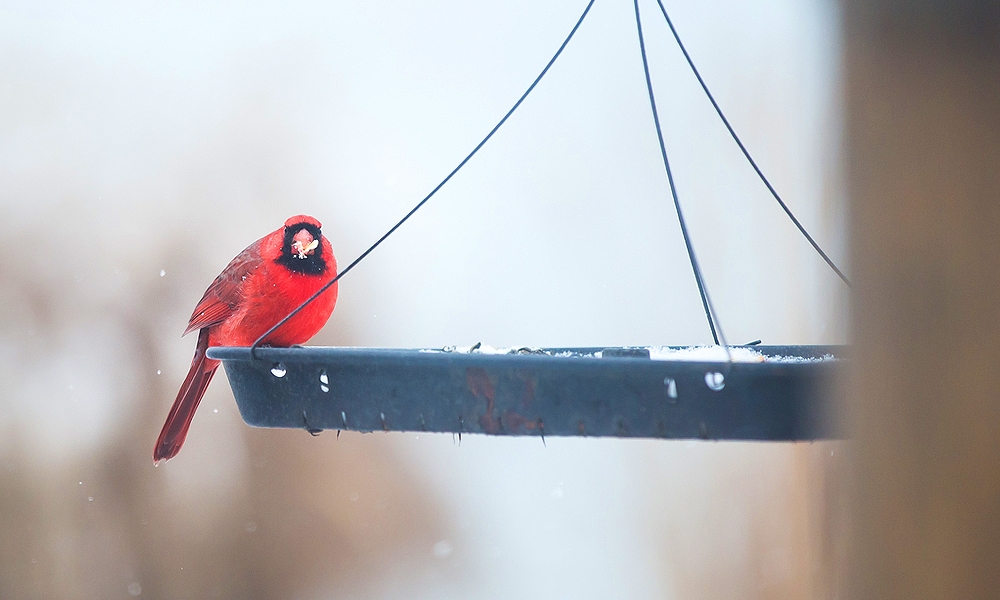
Temporary flocks consisting of 5 or more pairs band together. Flocks of cardinals can get as large as 70 birds during wintertime and often nest in bushy thickets. A flock of cardinals is called a college, radiance, conclave, or Vatican. These flocks make a stunning sight when spotted in a snowy landscape.
13. Cardinals are very territorial
Male cardinals will defend their zone from possible intruders, or even reflections. This is why you may have seen a male cardinal attacking a window or mirror. Though sometimes females are seen doing this as well, mainly males will attack what they think is an intruder, but they are really attacking themselves.
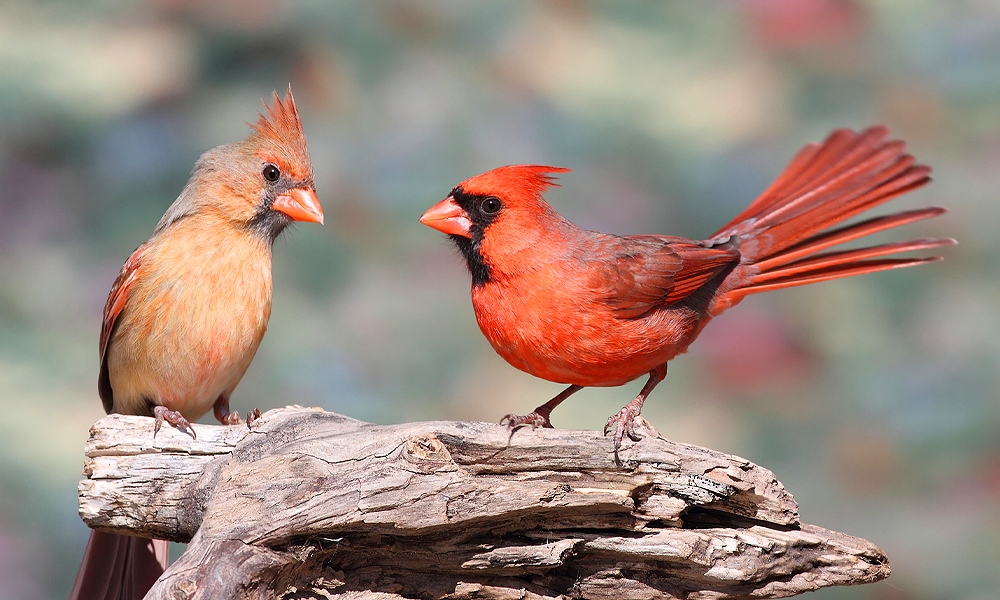
Cardinals become territorial over their range during nesting and breeding season because they are protecting their established habitat. Male cardinals are so hot-blooded that even though they breed near other bird species, they will never allow another male cardinal to trespass on their property. Though not the largest wild birds, cardinals are one of the toughest.
14. Cardinals are under The Migratory Bird Treaty Act
In 1918 the Migratory Bird Treaty Act was passed to give cardinals protection, including the prohibition of their sale (5). This law was first enacted in 1916 to implement the convention for the protection of migratory birds between the United States and Great Britain, which acted on behalf of Canada.
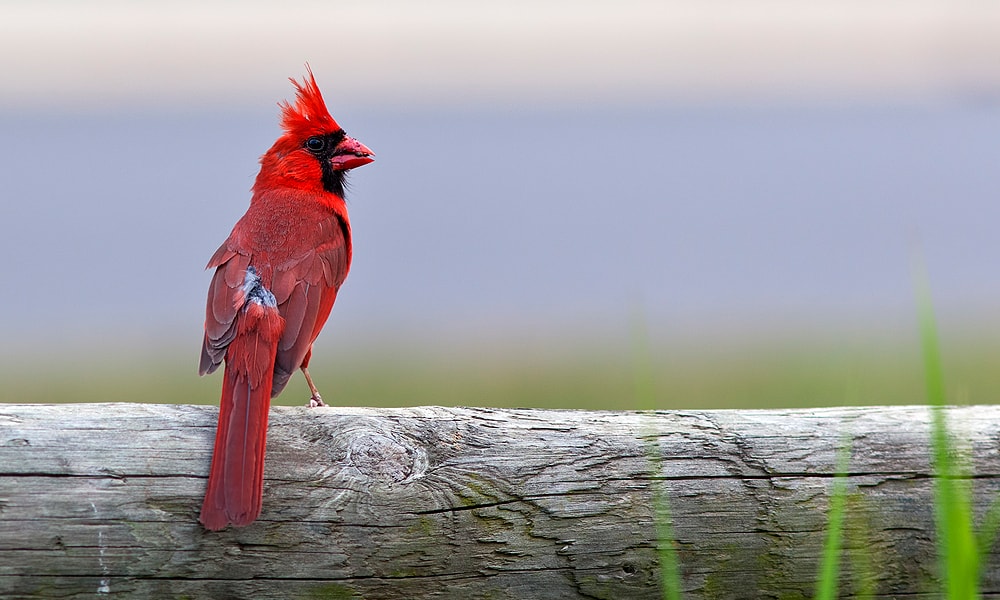
The statute makes it illegal without a waiver to pursue, hunt, take, capture, kill, or sell birds that are listed as migratory birds. Cardinals were popular in the 1800s as cage birds because of their brilliant red plumage and their singing capability. Once a threat to bird poaching, cardinals are now protected by this act and other legislation.
15. There are 19 cardinal subspecies
How many cardinals are there? There are many types of cardinals, a total of 19 subspecies which are mostly distinguishable by their colors. Northern cardinals live in a range from southeastern Canada to as far south as Louisiana. The Florida Cardinal (Cardinalis cardinalis floridanus) lives in Florida and Georgia.
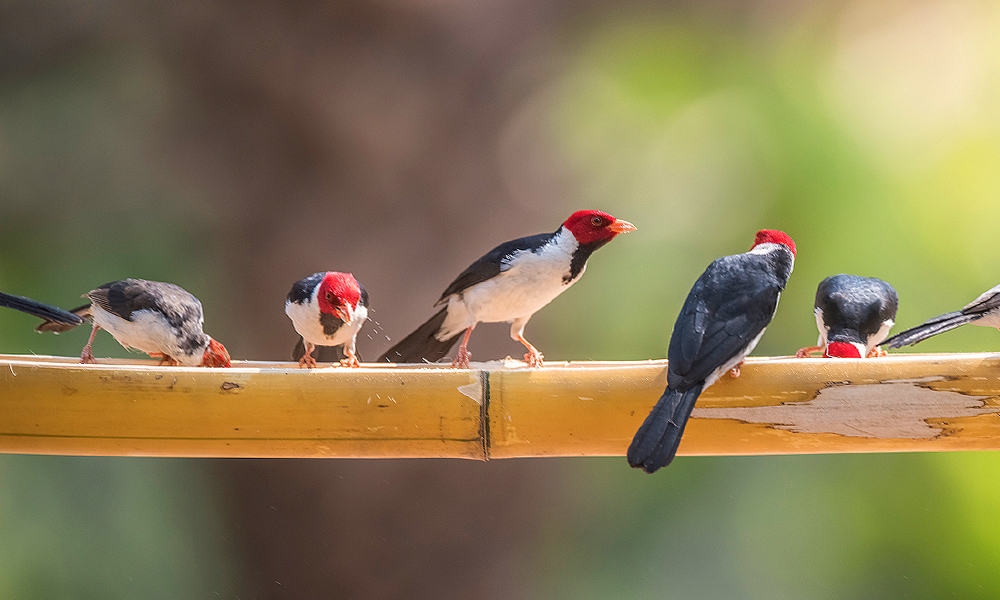
The Grey-tailed Cardinal (Cardinalis cardinalis canicaudus) lives in Oklahoma and Texas and throughout central and eastern Mexico. The Cozumel Northern Cardinal (Cardinalis cardinalis saturatus) lives in the Cozumel Islands in the Caribbean Sea off the eastern coast of Mexico’s Yucatan Peninsula. Cardinals belong to the Cardinalidae family, which includes Grosbeaks and Buntings.

I had two cardinals that would come every Spring and would get on my banister and dance and chirp back and forth, when my cat was on the window seal.
I felt they were teasing the cat, as if to say, you can’t get us!
When we first moved to the country three years ago, we spotted a couple of cardinals in our back yard. The second year, they never showed. We thought they’d been killed or hurt. This year, they showed back up again and brought another couple with them. So now we’ve got two male and two female cardinals in our back yard. Surprisingly, neither of the couples seem territorial. The fly and foraged side by side. They’re such beautiful birds.
I have a feed a few feet away from my office window in front of my house. I’m in Covington TN. I get 50 hits or more from Cardinals a day. Some I can distinguish. They give me a great peace of mind while I zoom meet across the world. I have an option to move down to Gulf Shores Alabama on the coast line about a mile in from shore. The yard has trees and bushes. I am wondering if Cardinals hang out in such territory so close to the beach. If not, I’m probably not going to go. I need my Cardinals.
I just googled “do cardinals live in coastal Alabama?” And I got info about cardinals in Alabama, didn’t really read it but thought you could google it for yourself.
Good luck.
Well im n Arizona now down in Green Valley, just rented a ranch house as we were just married. Iv ben watching dov3s n finches n Cardinals all day on the birdfeeder, i could do this forever, However, the birdlife n Florida i feel is the most diverse n the best..im from. Treasure island. Area.. Ft Desoto park my fav….The storks.black headed Amazon parrots…Pelicans.egrets.Herons..endless..cormorants…lovecFlorida.. Go…!!!!
It’s summer, and I have two pairs of cardinals coming to the feeder. Is this unusual?
I have 2 sets also but one male has chase away one male cardinal. He was first in my backyard and now I see him by him self and the other male cardinal is being mean to the female. I don’t know what to do. Please help
I also experience similar situation. I have two sets of cardinals. One is a male with three baby cardinals and the other is a pair of cardinals. The male cardinal from the pair is being mean to the father and prevent him and his youngsters from coming to the bird feeder in my yard for feeding. The pair chase him and the baby cardinals away. Similar to what you saw, Sanjuanita, I have seen the father coming to the bird feeder alone some time for the last few days. However, he stopped coming this morning. He’s a great father feeding the young every single day. I enjoyed watching him for the past few weeks. Any ideas on what might have happened. Did he move to another location? Hope he and his youngsters will be back some day.
Your problem would be easily solved if you put two feeders on the property some distance apart. After all, that one mean cardinal can’t be at two feeders at the same time.
Greetings from Maryland. We have a set of cardinals. The male appears to be missing his cap. There are feathers and it appears to be all black but no pointy cap. Any thoughts?
Hello Marryland!
I’m in Alexandria, Va. A male cardinal has been getting closer and closer to me whilst I sit on my front porch; his record is about four feet. He’s tutored me in cardinal speak at times.
He’s got a baldish patch on his head as well. I’m thinking he bashed his self on a window.
He’s still all cardinal and my best front porch friend!
I’m in Oklahoma City, and I have a wooded back patio, and right now I can count 15 male cardinals and I’m assuming there are 15 female cardinals as well, but they are harder to count. I have two feeders and the Cardinals are very active trying to get to the sunflower seeds.
I wonder about the bright red color of the Cardinal. One would assume that such bright red color might attract predators and, thus, it would be a disadvantage to be so conspicuous. Apparently, the Cardinals don’t agree with me. Any thoughts on the matter?
Thank you so much,
Edna
We have a pair of cardinals living in a big bush. I see both of them every morning at the feeder however, the last two mornings I have not seen them. My question is Why? Are they sitting on the next waiting for eggs to hatch? Do their diet change after laying eggs? Or after the eggs hatch? We just moved to Virginia and this the first time we have gotten to watch a pair of cardinals so we know very little.
I wanted to know how friendly Red Cardinals are. There is one particular couple that live just over my fence on my neighbors side and for three years now I have been bathing mainly the male with my water hose. It all happened quite naturally as I was watering my yard and it was super hot( Houston, Texas) he came close, standing on a low tree branch and just let me spray him for a looong time. It has happened many times over the years, he comes very close to me and I was wondering if it was common or actually something special as I’d like to think 🙂 Thanks 🙏
As long as they don’t see you as a threat, they will eventually become familiar with you enough to tolerate your presence- this goes for most wildlife.
I have two seating areas in my yard, and the birds have come to understand that I am just a benign part of the landscape and they completely ignore me. I’ve even had them land on me (and poop) lol.
Anyway, my resident cardinal pair is completely tame around me- but ONLY me. The male has even used me as a “babysitter” of sorts, he’s got a dumb youngster that pesters him nonstop while the female is on another nest, and he’s decided that leaving it parked near me in the best option lol. I put out a small handful of sunflower seeds for it, and it hangs out all day with me when I am gardening.
Enjoy your encounters with these gorgeous birds. Some say a cardinal is actually a visit from a departed loved one’s spirit…
We have three chicks that just hatched yesterday in an azalea bush. Too cool!!!
There is a saying that when you see a red bird, give him three kisses and make a wish, it will definately come true. This is the natural power of Northern cardinals. These are my favorite birds, Thanks for sharing.
Do the male and female share the nest at the same time? I don’t remember ever seeing a cardinal nest. Are there any distinctive characteristics?
I have a pair of cardinals at my house here on Indiana! Have seen them for the entire 4+ years now! So interesting to watch them!
Hello from Florida
I have three pairs of Cardinals besides Titmice and Nuthatches that come to my trough type feeder at my front door. I found a particular treat that will attract Cardinals as well as Titmice and Nuthatches more than anything. It’s unsalted dry roasted peanuts but to really attract them is unsalted cashews. A friend was so amazed on how so close they would come to me I instructed her to keep her hands to her side with no other body movement besides the movement of her head she got within two feet of the Cardinals feeding on a elevated platform 5 ft off the ground. This is with her just standing near where the food was and the Cardinals coming up to feed she was totally amazed and thrilled. You could try your own experiment by putting out a unsalted dry roasted peanut next to unsalted walnut and a unsalted cashew. The cashew will be gone first every time. I only add a little bit every day to my feeders so not to get them totally dependent on the cashews as the only food source. I added a flat elevated platform in my backyard so one particular Cardinal cannot dominate one feeder. The result is having them fly around and near me as they navigate around the house. The Cardinal will always be the first and last to eat every day. I have had a Nuthatch fly into my house looking for cashews more than one time when I ran out while leaving the doors open multiple times while only had a male Cardinal fly in once. Cardinals are picky about clean water also so keep the bird baths clean.
How do you keep the squirrels away? I have a constant battle with them just keeping them off my “squirrel proof” feeders. They’d “eat me out of house & home” if I had a trough or platform!
I put vaseline on my shepherds hook pole where my bird feeder hangs. Seems to be working. Also water in a spray bottle works too. As soon as they see me they run away.
I mix a product called “Angry Squirrel” into my bird seed an they don’t go near it. It’s been a game changer.
Here as well, and Cardinals prefer to eat from my deck railing. However the squirrels chase them away. So it’s difficult to have a balance of birds and rodents.
Male hit window died. Female will not stop heating . Will Continually go around the entire house hitting windows is ongoing been 3-weeks now it’s been three weeks OK Help please it’s so Frustrating.
Clip a picture of a person out of a magazine and place it on the inside of the window they are attacking. They’ll think someone is in the window and will stop hitting it. It worked for us.
I have had a red cardinal pecking and flying against my windows for the past 2years. It pecks on the windows at night too. I don’t know how to get rid of this bird. Drives my cats nuts cause the cat and bird are eye ball to eye ball against the window.
It’s November in SE Texas. I generally have 6 male cardinals and many more females, but for about 2weeks now they have disappeared. They did this last spring and were gone for a month!
I live out on 20 acres surrounded by wooded area! So, I know that they’re not eating at the neighbors. Ha!
Where are they? I miss them!!!
Hi! I live in Dallas suburb. My cardinals have disappeared for several weeks. Even at my walking trail they are gone. What happened? They brought me so much joy😔
This is a great article! New and interesting facts, easily read and understood. Thank you!
I put out seed for the cardinals all year. I live in NE Texas. This week the cardinals are gone. I have contacted friends and neighbors. They don’t see any either. Where are they?
Frances FOX
Hi Frances, Did the Cardinals leave as Hurricanes and storms were in the area? Did they return?
My song birds all seemed to have disappeared, as well; however, upon doing more research, I learned that they go into hiding while molting. Molting makes birds more of a target for predators, so they tend to hide while undergoing this process. I noticed it had gotten quiet here in the PA suburbs and was so sad to not see my sing birds, but they’re back now.
This past week, I kept hearing the double chirp of a baby cardinal and the answering parent chirp back, but I couldn’t see the wee one. I finally spotted her in my lilac bush.
The past 2-3 days, she’s been hoping around on my deck, happily chirping away! These beautiful creatures bring so much joy to my day! I hope yours have returned!
Thank you. I have a nest of Cardinals outside my window. I’m hoping the babies make it and live a long life. They’re so fascinating. Will our movement in our yard scare the parents away from raising the babies??!
We have a clear view inside a nest right outside our window. Your movements in the yard won’t scare them. They might fly away from the nest when you get too close but will land near by to “sing aggressively” at you until you leave the area, especially if they have eggs or young in the nest. They’re fun to watch.